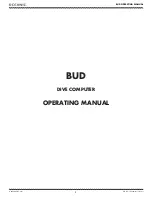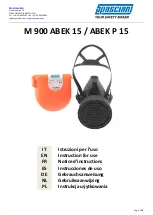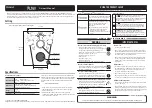
29
This value should be kept low if you want a fast response. Press
Modify
to select the desired number of samples to average. This value can be
set from 1 to 20 samples.
The default value is 1
.
Note: Each reading takes 1 second, so when logging the first
sample will be delayed by a few seconds if averaging is used.
HI9819X
’s calibration routines are accessed by highlighting
“Calibration” and pressing
Select
from the main menu. Calibration is
the process that standardizes the electrical signal from the sensors to
reagent standards of known value.
Calibrations are intuitive and menu driven. All calibration data is
stored in the non volatile probe memory, allowing probes to be connected to different meters without
recalibration. There are two types of calibrations available: the “Quick calibration”, which is used for a
single point calibration of pH, conductivity, and/or dissolved oxygen and is handy for field work; and the
Single param. calibration
that allows each parameter to be calibrated individually. The user may
also restore each parameter to a factory default calibration.
Note: The password will be required if password protection is enabled.
To optimize measurements, it is advisable to establish the optimum calibration period required
for the measurement environment. Calibration requirements vary with deployment conditions, for
example very turbid biologically‑active waters may require more frequent cleanings and calibrations
than cleaner waters. General calibration guidelines are listed below:
• Set up a routine service schedule where measurement integrity is validated. This is especially
important for new installation sites or long deployments.
• Inspect sensor connectors for corrosion and replace damaged sensors.
• Inspect sensor O‑Rings for damage and if necessary replace and lubricate with the grease found
in the probe maintenance kit.
• Do not handle the sensing surfaces of the sensors.
• Avoid rough handling and abrasive environments that can scratch the reactive surfaces of the
sensors.
• Avoid long‑term exposure of sensors to bright sunlight. If possible, calibrate in a shaded area.
• Discard standards after use. Do not return the used standards to the bottles of “fresh” solution.
• For measurements across a temperature gradient (when water temperature is drastically dif‑
ferent from the standards), permit the sensors to reach thermal equilibrium before conducting
calibrations or making measurements. The heat capacity of the probe is much greater than the air
and the small beakers of calibration standards.
Chapter 7 - CALIBRATION MODE
CALIBRA
TION MODE
Summary of Contents for HI98194
Page 9: ...9 SENSOR AND PROBE INSTALLATION ...
Page 25: ...25 SETUP MENU STRUCTURE ...
















































